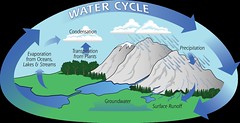APES Chapter 3 Flashcards
Terms : Hide Images [1]
| 11250963289 | Ecosystem | Particular location on Earth distinguished by its particular mix of interacting biotic and abiotic components. | 0 | |
| 11250963290 | Producers | Also known as autotrophs. They use solar energy to produce usable forms of energy with photosynthesis. | 1 | |
| 11250963291 | Autotroph | An organism that makes its own food via photosynthesis or chemosynthesis | 2 | |
| 11250963292 | Photosynthesis equation | Solar energy + 6 H20 + 6 CO2 turns into C6H12O6 + 6 O2. | 3 | |
| 11250963293 | Cellular Respiration | Process by which organisms produce ATP energy by breaking down Sugar. Glucose + Oxygen --> Water + ATP Energy + CO2 | 4 | |
| 11250963294 | Consumers/Heterotrophs | Organisms incapable of photosynthesis. Must get energy from consuming other organisms. | 5 | |
| 11250963295 | Primary Consumers | Organisms that consume producers (typically herbivores) | 6 | |
| 11250963296 | Secondary Consumers | Organisms that eat primary consumers (typically carnivores or omnivores) | 7 | |
| 11250963297 | Trophic Levels | Feeding levels. | 8 | |
| 11250963302 | Decomposers/Detritivores | Fungi and bacteria that complete the breakdown process by recycling the nutrients from dead tissues and wastes back into the ecosystem. | 9 | |
| 11250963303 | Gross Primary Productivity | Total amount of solar energy that the producers in an ecosystem capture via photosynthesis over a given amount of time. | 10 | |
| 11250963304 | Net Primary Productivity | Energy captured minus the energy respired by producers. | 11 | |
| 11250963305 | Biomass Pyramid | Diagram that shows the amount of biomass at each trophic level. Pyramid in shape. |  | 12 |
| 11250963306 | Numbers Pyramid | Diagram that shows the number of organisms that occupy each trophic level in a given ecosystem. Pyramid in shape. |  | 13 |
| 11250963307 | Ecological Efficiency | Proportion of consumed energy that can be passed from one trophic level to the next | 14 | |
| 11250963308 | Trophic Pyramid | Diagram that represents the amount of energy at each trophic level. Decreases by about 10% each time | 15 | |
| 11250963309 | Biogeochemical Cycles | Movement of matter within an between ecosystems. | 16 | |
| 11250963310 | Hydrologic Cycle | The pathways water takes as it travels through Earth's spheres/systems. |  | 17 |
| 11250963311 | Evaporation | Transformation of liquid water into water vapor | 18 | |
| 11250963312 | Condensation | Water vapor goes from a gas to liquid often to form clouds | 19 | |
| 11250963313 | Transpiration | Plants release water from their leaves into the atmosphere | 20 | |
| 11250963315 | Runoff | Water moving across land surface and into water bodies, eventually reaching ocean. | 21 | |
| 11250963316 | Carbon Cycle | The movement of carbon through Earth's spheres/systems. Largest reservoir is rock/geosphere. Largest sink is the ocean. | 22 | |
| 11250963317 | Photosynthesis | Process by which producers/autotrophs capture the energy of sunlight and store it in sugars. | 23 | |
| 11250963319 | Limiting Nutrient | A nutrient whose amount available limits growth of organisms. | 24 | |
| 11250963320 | Nitrogen Fixation | Process by which bacterial organisms convert N2 into ammonia NH3. | 25 | |
| 11250963321 | Assimilation | Process where an organism takes up or consumes a nutrient. | 26 | |
| 11250963322 | Ammonification | Process by which bacteria (decomposers) in soil and water break down biological nitrogen compounds into ammonia. | 27 | |
| 11250963323 | Nitrification | Process by which Bacteria convert ammonium NH4+ into nitrite NO2- and then into Nitrate NO3- | 28 | |
| 11250963324 | Denitrification | Process by which bacteria in oxygen poor soil and stagnant water convert nitrate into nitrous oxide N2O and nitrogen gas N2 | 29 | |
| 11250963325 | Nitrogen Cycle | The movement of nitrogen through Earth's spheres/systems. Largest reservoir is the atmosphere. | 30 | |
| 11250963326 | Leaching | Process by which nitrates or other minerals are transported through the soil with water. | 31 | |
| 11250963327 | Phosphorus Cycle | The movement of phosphorus through Earth's spheres/systems. Largest reservoir is rock/geosphere. Weathering of uplifted rocks contribute phosphates to the land and some phosphate make their way back to the ocean. It is NOT found in the atmosphere. | 32 | |
| 11250963328 | Eutrophication | Caused by excessive phosphates and nitrates in bodies of water. Leads to overgrowth of producers (usually algae), followed by decomposers, and low oxygen conditions. | 33 | |
| 11250963329 | Algal Bloom | An immediate increase in the amount of algae and other producers that results from a large input of a limiting nutrient - typically nitrogen or phosphorus. | 34 | |
| 11250963330 | Hypoxic | An area that is deficient in oxygen. Typical during algal bloom/eutrophication. | 35 | |
| 11250963331 | Watershed | All of the land in a given landscape that drains into a particular stream, river, lake, or wetland. | 36 | |
| 11250963336 | Tertiary consumer | Carnivores that eat secondary consumers. |  | 37 |
| 15321999884 | Carbon Sink | anything that absorbs more carbon that it releases (plants, ocean, soil) | 38 | |
| 15322007259 | Carbon Source | Anything that releases more carbon than it absorbs (Forest fires, animal respiration, burning of fossil fuels) | 39 |
